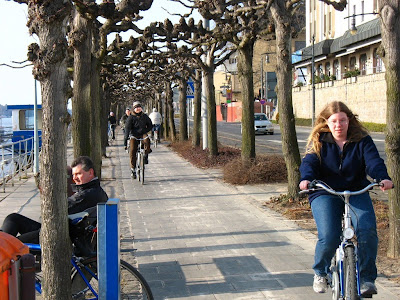If walking, bicycling, and public transport are seen as modes of last resort by these folks (and the government bodies that fund them), then they will become such. They will be underinvested and poorly designed. And when they do become choices of last resort due to lack of investment, then the people who travel by these modes will automatically appear inferior and even suspect. We have been in this position. Things are, actually, getting better. But this realization hasn't really filtered up to the top levels of decision-making.
I recently came across my stash of photos from my first trip to Germany (visiting my uncle in Bonn, a small city along the Rhine in the northwest). Germans certainly love cars as much as Americans do (which does not equate to loving traffic), and they have their Autobahn to match our Interstate highways. But they also have choices.
All modes considered: the Autobahn, the real bahn (train), city streets and sidewalks, tram station, and riverside bicycle path
The train service is spectacular. Any decent-sized town has several passenger trains per hour that will take you to nearby cities in every direction, not to mention commuter trains, regional trains, and so forth. You can take your bicycle on the train in designated cars; some trains even have special racks or spaces for them.
It's easy to connect to the train or tram by bicycle. At Bad Honnef, the path ran adjacent to the tram, separated by a small hedge. This is how I envision the Atlanta BeltLine.
There is tons of bicycle parking at the train station. They also have indoor parking and a repair shop.
In the city, multimodal traffic is considered in every setting. Sometimes the resulting compromise leaves something to be desired. But it is always addressed. On one-way streets, a two-way cycle track may be provided so that cyclists are not inconvenienced. Bicycle routes are well marked.
And in pedestrian zones at the city center, you must walk or park your bicycle due to large numbers of people walking and shopping on foot.
Bicycle routes are designed to be attractive and pleasant. Important connections are provided, such as the side rail for walking your bicycle up and down the stairs.
We rented bicycles at the train station and had a fantastic day touring nearby towns along the Rhine. I think that's when I finally realized what bicycling could be.
















I've studied bike infrastructure in Europe too. It's easy, convenient and safe. It'll come to the U.S. eventually.
ReplyDeleteI noticed that my brothers BMW doesn't have cup holders, and he noted that "Germans don't mess around in the car. They just drive."
I feel like the US has to discover its own native bicycle infrastructure. Not sure what that will be. And certainly there are lots of 'best practices' we can learn from Europe. But here, I believe it will have to build off of national and even regional culture - hopefully without compromising safety and such...
ReplyDeleteI love this post, and all your photos of Bonn and the Rhine. I have some wonderful memories from there myself, and have always wondered at why we don't take a better look at some of those "best practices." Bicycling is almost looked at as evil here, heaven forbid you share the road with those big navigators and the like. They get downright ugly at times. I think it is nationalistic pride that stands in the way of ever looking towards another paradigm. Bikes should not share the road with cars. The enlarged sidewalk makes so much more sense.
ReplyDelete